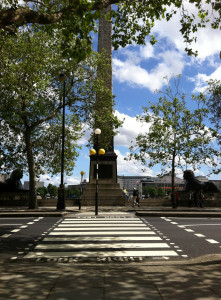On the river bank, close to Embankment underground station in the city of Westminister you will find the obelisk commonly known as Cleopatra’s needle. It was presented to the Great Britain by Muhammad Ali in 1819 the then ruler of Egypt and Sudan. It was given to commemorate the victories of Lord Nelson at the Battle of the Nile and Sir Ralph Abercromby at the Battle of Alexandria in 1801.
However the obelisk remained in Alexandria until 1877 till a sponsor arranged for it’s transport to London, ironically enough the then British goverment of 1819 had accepted the gift but refused to pay for it’s transport!
During transport a rescue boat capsized with the loss of six crew members when the transport boat ran into trouble during a story in the Bay of Biscay. After some more transport problems It was finally erected on the Victoria Embankment on 12 September 1878 with a time capsule consealed in it’s pedestal.
The needle is flanked by two bronze sphinxes baring the inscription netjer nefer men-kheper-re di ankh “The good god, Thuthmosis III given life”. It’s interesting that the embankment itself has a line of benches held by winged sphinxes on the armrests.
The needle itself has no connection with Queen Cleopatra VII of Egypt at all! It was already over a thousand years old during her lifetime. It was originally erected in Heliopolis by the order of Thutmose III in 1450 BC. The inscriptions were added about 200 years later by Ramesses II to commemorate his military victories (A man who enscribed every spare monument he could get his scribes on). The obelisk was moved to Alexandria and set up in the Caesareum by Cleopatra in honor of either Mark Antony or Julius Caesar around 12 BC. They later toppled into the sand which had the benefit of keeping the heirogryphs in good condition.

